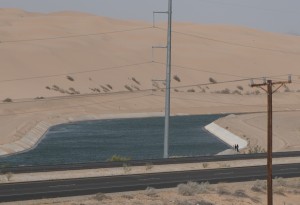The University of New Mexico water posse had a great visit yesterday with Christopher Scott, the new director of the Udall Center for Studies in Public Policy at the University of Arizona. Scott spoke a couple of times and met with students at our Community and Regional Planning program, who have been doing a lot of work on wastewater reuse (shoutout to Caroline Scruggs, who’s leading this effort, and who hosted Scott).

All-American Canal passing through the sand hills west of Yuma, March 2014 by John Fleck
Scott talked about the work he’s been doing in this same area, which raises non-trivial questions with deep implications for what happens when you “conserve” water – the fact that the water you “save” was often doing something useful somewhere else, whether you meant it to our not. Like a sewage treatment plant outfall into a river. Or, as from this 2014 paper, water leaking from the unlined All-American Canal on the Lower Colorado River that recharged an aquifer:
[I]ncreased efficiency in the Imperial Valley has been pursued largely with the objective of transferring water out of the basin for urban uses – an example of the sectoral paradox, with a resulting decline in local within-basin resilience including reductions in aquifer recharge that had previously resulted from seep- age across the US–Mexico border.
I don’t remember for sure, but I think it was that paper by Scott and his colleagues that introduced me to Bruce Lankford’s idea of the “paracommons”, which I wrote about here (one of my favorite comment threads ever on an Inkstain post there, check out Tom Buschatzke’s contribution), and which was influential in my book’s conclusion. I’d been struggling with the ideas involved – Scott and Lankford provided some conceptual clarity for this passage. When you “conserve” water and leave it in Lake Mead, whose water is it? Yours to use later? A common property of the system as a whole?
Given that, overall, water users are demanding more water than nature is providing, sooner or later the water that is conserved will have to be water that no one will ever get back.
More than a year after I delivered the manuscript for my book, that question remains at the heart of discussions around solving the Colorado River’s problems. It won’t be easily sorted.

You point out the difference between consumptive and non consumptive uses of water. Most indoor residential use is essentially non consumptive as water leaving in the sewer is more or less the same as water coming in at the meter. Outdoor usage is of course a different matter, as is industrial usage where water is used for cooling and a lot goes up in steam.Of course in the west you also have evaporative cooling of homes, which is a consumptive use.